Conditions and factors promoting the movement of agricultural producers towards innovation-based development
Автор: Sovetov Pavel Mikhailovich, Volkova Svetlana Anatolevna, Sovetova Nadezhda Pavlovna
Журнал: Economic and Social Changes: Facts, Trends, Forecast @volnc-esc-en
Рубрика: Branch-wise economy
Статья в выпуске: 4 (34) т.7, 2014 года.
Бесплатный доступ
The article considers the results of the questionnaire survey carried out in 2011-2013 by the Department of Production Management at the Vologda State Dairy Farming Academy named after N.V. Vereshchagin. The survey was supported by the Vologda Oblast Department of Agriculture, FoodStocks and Trade in the framework of ongoing research into the issues of transition of agricultural economy to innovation development. The authors present and systematize the opinions of the heads of the region's agricultural enterprises concerning the challenges and opportunities of innovation-investment activity of agricultural organizations.
Innovation, demand for innovations, innovation activity
Короткий адрес: https://sciup.org/147223622
IDR: 147223622 | УДК: 332.14.001.895 | DOI: 10.15838/esc/2014.4.34.19
Текст научной статьи Conditions and factors promoting the movement of agricultural producers towards innovation-based development
Russia’s accession to the World Trade Organization (WTO) attaches greater importance to the enhancement of competitiveness of modern agriculture that operates under conditions of international division of labor and emergence of new markets. Agricultural producers realize that they need to improve the competitiveness of their products and production conditions in order to ensure the production of high-quality and safe products that meet and even anticipate the demands of consumers. The tactics to achieve economic growth commonly used in the 2000s was based on the existing range of products and launch of idle capacities, fixed assets and technology; this tactics cannot ensure the required competitiveness of enterprises at present and in the future.
Competitiveness, of course, depends on the level of resource usage efficiency and intensification of production, but if Russia wants to produce competitive products being the WTO member, it should enhance their quality, launch new, marketable production in accordance with the requirements of the globalizing market. This requires updating of basic production assets, their reconstruction and creation of new production facilities, the adoption of progressive technology. All this requires investment, which are the main factor promoting economic growth, its main driving force.
In the conditions, when the quality of economic growth is the most important and it increases when production shifts to new goods manufactured using upgraded production facilities, investment in innovation becomes the most important direction for the use of investments. And today it seems that the Russian Federation does not lack suggestions to develop its economy based on innovation. The country’s innovation development model is set out in the Concept for long-term socio-economic development of the Russian Federation [4]; it should result in the creation of innovation economy. State authorities are talking more and more about financial support to innovation activity.
However, official statistics do not show the growth of demand for innovation and the increase in the volumes of innovation products, including those from manufacturing industries that lay the foundation of economic competitiveness. There is no intensive technological re-equipment of domestic industry, and, moreover, unlike all other industrialized countries, Russia is not reducing the share of the low-tech sector in the structure of value added. Only about 10% of enterprises in the country, like a decade ago, implement technological innovation, whereas in Germany the figure is 60% [2]. Hence, some scientists, who study the model of innovation economic development, postulate that private owners of enterprises do not want to or cannot finance the innovation process [2].
This opinion is based on an extensive foundation of empirical evidence, but statistics show that some industries and enterprises that are in the same functioning conditions, are, nevertheless, able to find the funds for adoption and implementation of innovation development strategy. Here we do not focus our attention on the characteristics of produced innovation products that are new for the internal or external market or that do not have analogues on the world market. It is clear that it is not always possible to launch the production of innovative products with low costs.
And now, as competition is getting tougher and Russia’s economy is open to multinational corporations and WTO rules, agricultural producers will have to improve production processes and quality of their goods that remain competitive, and to increase productivity. We think that this approach is very important under the current conditions of production and circulation, because not all agricultural companies have the potential for innovation development and opportunities to establish high-tech production in short term. The research and regular contacts with leaders and specialists of agro-industrial complex (AIC) show that they support the imitation approach to innovation, since it complies to the objectives of enhancing the basic conditions of reproduction and improvement of the overall climate for agribusiness.
Agricultural economics and AIC management practice is well acquainted with strengths and weaknesses of the current innovation system; they can be viewed from different angles, but its potential should be perceived, first of all, as an actual foundation of available competitive advantages based on scientific knowledge; one must use these advantages most efficiently to achieve sustainability and growth of expanded reproduction in agriculture.
Actually, this was one of the pillars of a concept of research that we carried out in 2011–2013 to study the factors and conditions promoting innovation development of agricultural economics in the region in the case of the Vologda Oblast.
One of the stages of the research was to collect and generalize the opinions of the heads of agricultural enterprises in the region concerning the challenges, opportunities and prospects of innovation development. This was carried out through questionnaire surveys of the leaders of agricultural organizations; they were asked a specific set of questions to identify factors promoting or hindering innovation and investment activity of crops and livestock producers. The questionnaires were distributed to the heads of agricultural enterprises specializing in the production of dairy cattle and located virtually in all the administrative-territorial districts of the region.
The list of enterprises was approved by the leadership and economic service of the Vologda Oblast Department of Agriculture, Food Stocks and Trade. The total number of farms that had submitted filled-in questionnaires, was 52. This covers over 24% of the general totality of dairy farms, located on the territory of the region; this allows us to speak about high representativeness and credibility of the survey.
When we set the goal, we took into account the vulnerability of domestic agricultural economy [1] and the existing groups of current and long-term problems (economic, demographic, social), as well as the general conditions and specifics of functioning of agriculture. The first year of Russia’s membership in the WTO, as it is quite obvious, dictates that enterprises should not only increase competitiveness of their products, but also create the conditions for its production, ensuring quality and safe products that satisfy and even anticipate the demands of consumers.
Now, due to large-scale and prolonged pressure of food imports in the context of globalization and economic openness, the issue of competitiveness of domestic agricultural products on the internal market is most acute (you can say, critical). And this cannot be solved by boosting agricultural production alone.
Negative demographic trends in rural areas, which are manifested in the decline in birth rate and growing death rate of rural population, high unemployment and low incomes dictate the necessity to move the whole rural economy to innovation development. Here, in the first phase of the study, we will consider only the key link – agriculture – in the views of heads of agricultural organizations concerning the challenges and opportunities of implementing innovation development in agricultural economics.
Generalization and structuring of the questionnaire survey data clearly shows that heads of agricultural organizations do not deny the importance and significance of working out a strategy for innovation development of agro-economics; and they evaluate the market of innovations in agriculture as growing and developing, where scientific and technological innovations are very expensive and their supply on the part of national science could be more extensive, in their opinion. At that, the main obstacle to innovation breakthrough in the development of agricultural production, according to the respondents, is, quite reasonably, the restriction of demand for innovations resulting from a man-made “agrarian tragedy” that has struck agricultural economics (the expression of L.I. Abalkin, 2009).
Therefore it is not a coincidence that only 13% of surveyed executives say that they are ready to start the transition of agricultural production to the innovation stage of development, 42% admit the possibility of such a transition in the future, but 45% report they have no conditions for the implementation of this transition. Note in this connection that only 5% of respondents are focused on the intensification of agricultural production, as it is indicated clearly in their responses. Most of the executives (57.5%) assess the utilization of available production capacities at the level of 70–80%, and 32% characterize the level of utilization of production potential at no more than 40–60%.
Of course, the figures should not be interpreted as unwillingness of heads of agricultural enterprises to solve problems of innovation development of agricultural production. At present, most of the respondents are implementing innovation to a greater or lesser degree (fig. 1) .
The highest level of demand for innovation projects, judging by the number of agricultural organizations that declared it and that are involved in implementing them, was found among those that are related to the purchase of equipment of new generation (29%), improvement of animal breeds (19%), somewhat less – among those related to the development of new production technology (17%), the use of improved varieties of plants, hybrids, crosses (16%) and very few among those related to the use of modified materials (fertilizers, herbicides, feed additives, etc.) (9%). Mastering of production of the products of genetic engineering and new types of products is only expected in the foreseeable future.
It should be emphasized that leaders of agricultural enterprises are objective and very critical in assessments of their activity in the field of innovation. For instance, only 22% of the respondents evaluated the activities of their enterprises in introduction of innovation technology in animal husbandry by five points (on the scale of ten).
All respondents assess the level of implementation of innovation technology in plant cultivation below five points, including 12 and 5% – by four to five points, respectively. While 37.5% of the respondents point out a 10% level of satisfaction of the demand for elite seeds, not more than 4%
Figure 1. Innovation projects participated by agricultural enterprises of the Vologda Oblast in 2006–2010, %
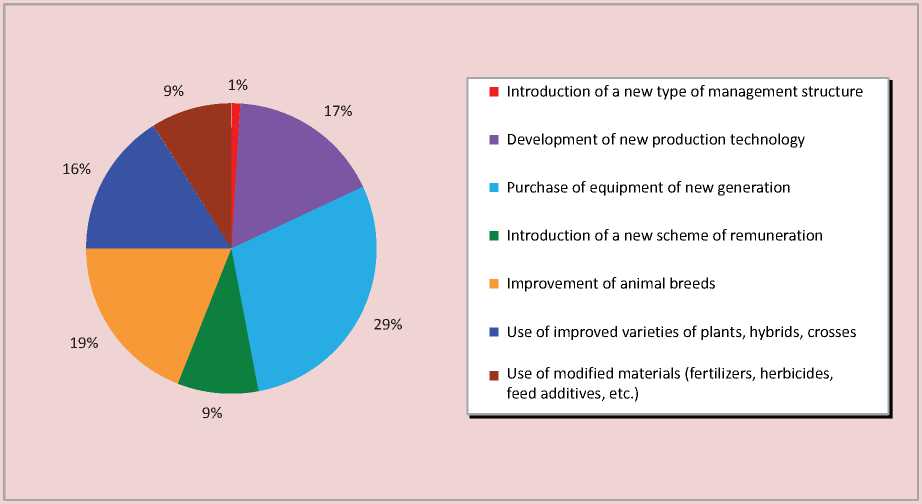
of agricultural producers say the demand is satisfied by 80–90%, and none of them is supplied by 100%. Half of agricultural producers has a 12% level of satisfaction of the demand for elite seeds.
11% of agricultural producers have solved the problem of purchasing pedigree livestock; it is solved by 90% in 5.6% of agricultural enterprises. 22% of agricultural producers have an opportunity to satisfy only half of their demand for pedigree livestock, and 44% of respondents – only in the range of 10–15%.
Leaders of agricultural enterprises that participated in the survey are distinguished by pragmatism concerning the launch of innovative activity inextricably linked with the formation of basic conditions for expanded reproduction.
First of all, they include the upgrading of facilities and infrastructure of agricultural enterprises, so that they had the ability to manufacture competitive products. Secondly, they include measures aimed at organizing the production of new (unique) products.
In this context it is logical that heads of agricultural enterprises are concerned with the condition and replacement of fixed assets. For example, for five years (2006– 2010) only 7.1% of respondents have fully upgraded their fixed assets, 33% were able to compensate for their retirement only by half, and 42% replaced only one-third of their retired assets.
Leaders of agricultural organizations are constantly arguing that capital investments allocated for the acquisition of long-term resource-saving equipment and technology, investments in human capital and infrastructure development are a necessary and major source of economic growth. They determine the possibility of increasing the efficient use of land, labor and other production resources, and ultimately the competitiveness of agricultural products.
In 2005–2010 the volume of capital investments in the development of production capacities, according to 37.5% of the respondents, was sufficient only for simple reproduction (fig. 2) ; 25% of respondents consider it insufficient for simple reproduction. Only 20% of respondents admitted that the level of capital investments was sufficient for extended production.
It is significant that when asked about economic performance of their enterprises for 2011–2013, all the respondents indicate an increasing degree of unfulfilled requests for capital investments, lack of capital investment to provide simple and expanded reproduction.
Official statistics points out continuous and widespread decline in construction of production facilities in agriculture; it is confirmed by the corresponding estimates given by the heads of agricultural enterprises, who participated in the survey. Only 15% of respondents said they had implemented the plans of construction of production facilities in the livestock industry in the period under consideration. The list and the importance of factors that hamper investments in agriculture (in the interpretation of survey participants) are shown in figure 3 .
The answers given by the surveyed heads of agricultural enterprises show interrelation between the tasks of growth of innovation
Figure 2. Assessment of the level of capital investments in the development of production capacities (as a percentage of the number of responses given by heads of the Vologda Oblast agricultural organizations, who participated in the survey)
47.5

2005-2010
2011-2013
□ Optimal
□ Sufficient for extended reproduction
□ Sufficient for simple reproduction
□ Insufficient for simple reproduction
□ Totally insufficient, causing irreversible effect
Figure 3. Factors hindering investments in agriculture (as a percentage of the number of responses given by the heads of the Vologda Oblast agricultural organizations, who participated in the survey)
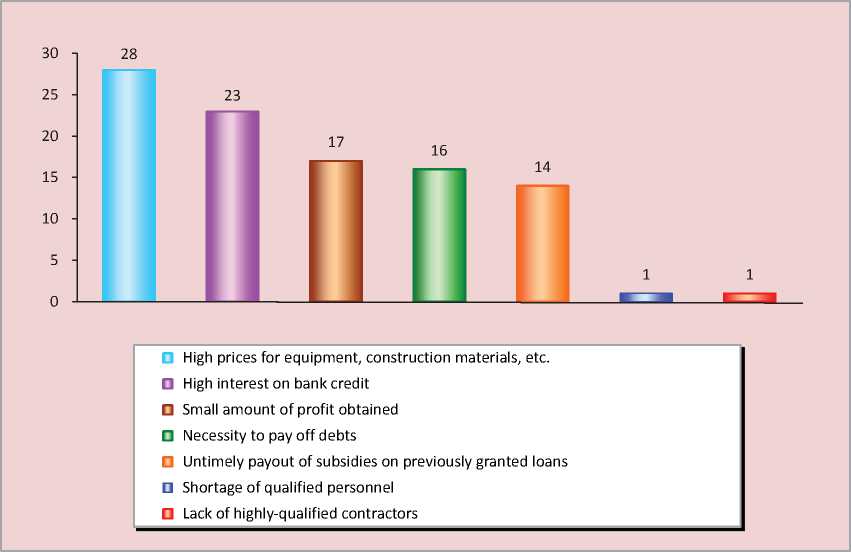
activity and capital investment in agriculture, where investment is a condition and prerequisite for transition to innovation type of development of agricultural production. Also there is a correlation between the estimates of the possibilities of transition to innovation model of development and the level of investment support provided to agro-economics.
Thus, 15% of the surveyed heads of agricultural enterprises consider the volume of investment for expanded reproduction to be sufficient, and almost as many executives (13.6%) say that their agricultural enterprises have opportunities for the transition to innovation model of development.
Accordingly, lack of capital investment treated as “totally insufficient”, leads to negative judgments concerning the possi- bilities of innovation development. The volume of investments, insufficient for simple reproduction, serves as a reason for a response such as “rather no than yes” concerning the estimates of opportunities for innovation development, whereas the parameters of investment that are considered sufficient for simple reproduction, form the answer “rather yes than no” (fig. 4).
According to respondents (fig. 5) , the main driving force in the transition to innovation model of development of agricultural production is the need to enhance competitiveness (30% of the total number of respondents). 23% of the answers of managers point out increased competition in the market and express their concern about the fact of Russia’s accession to the World Trade Organization (17%), instability of external environment factors (15%).
Figure 4. Evaluation of existing opportunities for transition to the innovation model of development of agricultural production in the Vologda Oblast (according to the results of the questionnaire survey of enterprises’ heads), %
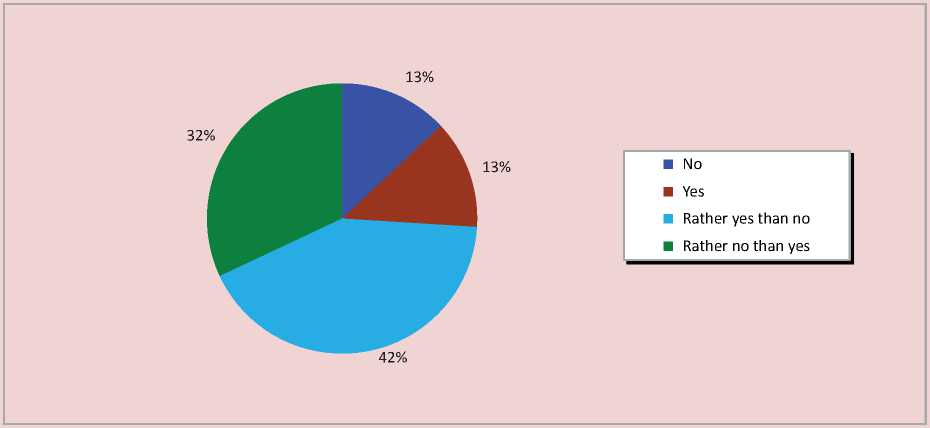
Figure 5. Factors promoting the transition to the innovation model of development of agricultural production in the Vologda Oblast (according to the questionnaire survey of managers), in %
3%
23%
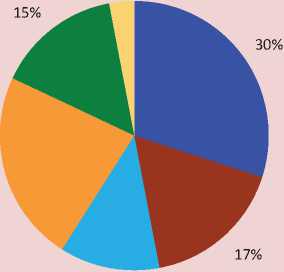
12%
-
■ Necessity to enhance competitiveness
-
■ Russia’s prospects of joining the WTO
-
■ Existing market conditions
-
■ Increase of competitiveness on the market
-
■ Instability of external environment
Other: conservation of production, depreciation of machinery and equipment
Leaders of agricultural organizations understand that transition to innovation model of development will be very difficult under the circumstances of socio-economic instability. It will be necessary to activate all the available resources and attract additional material, labor and intellectual resources; besides one will need a clear view of numerous risks and expected results, organization of target management of innovation, preparation and adaptation of personnel to innovation. It is clear that it can be achieved only with large-scale support and systematic participation of the state.
Therefore it is not a coincidence that heads of agricultural enterprises attach the greatest importance (41%) to the enhancement of state support of agriculture as a main condition for boosting innovation. The necessity of elaboration and realization of special target programs for innovation development (30%) is on the second place (fig. 6) according to the degree of importance and significance. The tasks such as forming the system of information and advisory support of innovations, increase of financing of agrarian science, improvement of forms and mechanisms of interaction between science and production are estimated as being somewhat less important, but equally important with relation to one another. So far only 1% of respondents stressed the importance of establishment of venture funds with participation of the state.
An appeal of agricultural enterprises’ leaders to the state for support should not be understood as a request for unlimited financing of expenditures on innovation at the expense of the state budget. We are talking about state protectionism of innovation development of agricultural production, similar to the one that emerged during the
Figure 6. Importance of tasks and conditions of transition to innovation model of development of agricultural production (according to the results of the questionnaire survey of managers), in %
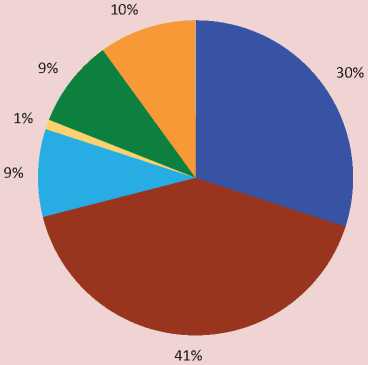
-
■ Develop and implement special target programs
-
■ Enhance the provision of state support to agriculture
-
■ Increase the funding of agrarian science
-
■ Establish venture funds with government participation
-
■ Improve the forms and mechanisms of cooperation between science and production
-
■ Establish a system of information and advisory support of agricultural producers in order to apply the achievements of scientific and technological progress
initial period of the “new economic policy” of the USSR and that was effectively applied in industrialized and other countries during the post-war period under the auspices of state paternalism in relation to agriculture. Today all that remains for domestic agricultural producers is nostalgia for large-scale public investment in agricultural production effected in 1976–1991, and dreams about “neoNEP”.
Agricultural producers would like to actually see and constantly feel the real state support of innovation development of agricultural production. In their opinion, the most important direction of government policy in promoting innovation in agriculture is to ensure protection from the pressure of natural monopolies, resellers or processors and to reduce tax burden on producers (fig. 7).
They emphasize the importance of restricting the import of agricultural machinery, raw materials and food, as well as the guarantees of state procurement of agricultural products manufactured with the use of new technology. The respondents point out certain very important activities of the state in implementing the following measures: development of innovation market infrastructure and leasing with the introduction of new equipment and highly productive breeds of animals, risk insurance in innovations, and tax incentives in integration links between agricultural
Figure 7. Choice by heads of agricultural organizations of the directions of the state policy in promoting innovation, in %
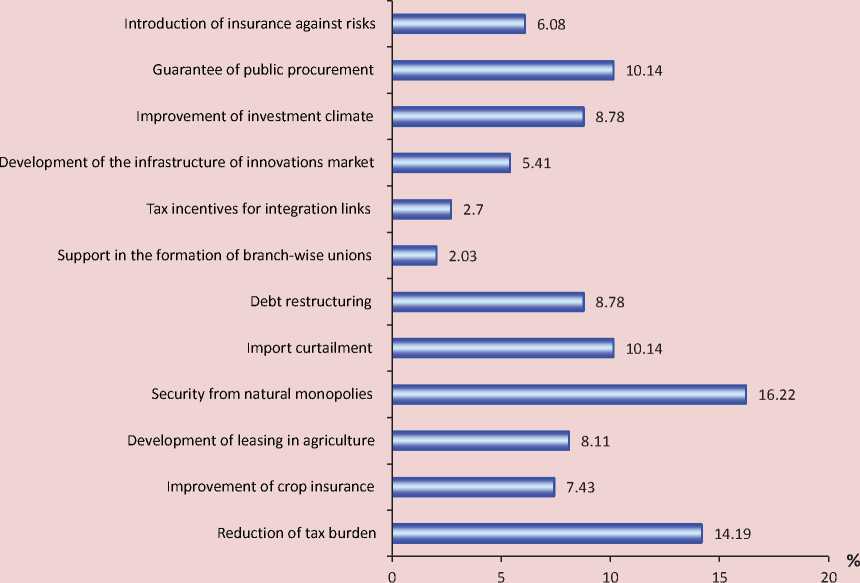
enterprises, processing and trade enterprises (agricultural holdings), on terms of mutual benefit, support in the formation of industrial unions of agricultural producers. Therefore, the opinion of the heads of agricultural organizations concerning state support of innovation development of agricultural production seems to be very informative and differentiated.
In this case, heads of agricultural organizations are not trying to shift responsibility to the state and get away from solving problems of innovation development of agricultural production. They do not tend to deny their responsibilities for the implementation of innovations. Reasonably believing that the success of the transition of agricultural enterprises and agricultural economics in general to the innovative model of development will be determined primarily by knowledge assets and the level of professionalism, they critically review the qualifications and willingness of their employees to develop innovations; they forecast the innovation activity of their employees and begin to work on the formation and development of innovation potential of human resources.
The leaders of agricultural organizations that participated in the survey have noted a relatively low level of sensitivity of the existing management personnel to innovation. In the opinion of leaders, 25% of managerial staff have a positive opinion concerning innovations and are willing to implement them into life, but 50% show low and average readiness to implement them. Only 6% of managers believe that specialists are able to express the positive nature of the results of innovation for the entire enterprise and its employees, and also have sufficient authority, motivation and interest in implementation of innovation projects at their enterprise. So far, only one in ten managers believes that the company’s specialists can sensibly explain the necessity and feasibility of innovations to production staff. None of the survey participants set the highest score to the management of their company for their ability to assess the factors in feasibility and success of innovation projects.
Consequently, it becomes obvious, undeniable and urgently necessary to raise the qualification of workers to the level required for independent development of innovation technology, and also to train managerial staff in the fundamentals of innovation management, and to train personnel in organizational behavior in the conditions of innovation development of economy.
The main part of the interviewed heads of agricultural enterprises (72.5%) consider it necessary at present to educate production personnel in the implementation of innovation projects, 17.5% do not deny this need. The rest (10%) do not consider this to be important and urgent.
The study of the opinions of heads of agricultural enterprises allows us to clarify issues related to innovation development at the enterprise level, i.e. at the level of the main component of economy, and see what the problem situation is, it also helps identify existing problems and assess the factors influencing innovative activity in agriculture.
Summarizing the results of our questionnaire survey, we emphasize the following:
-
1. Heads of agricultural organizations evaluate a market of innovation in the agricultural sector as a growing, developing one, where scientific and technological novelties are very expensive and their supply by the national science could be, in their opinion, much wider. Besides, attention should be also paid to innovation projects in the organization of production management, marketing and social technologies of formation of innovation-active management.
-
2. The promotion of innovation in agricultural production is, according to respondents, an objective necessity caused by the tasks to improve its effectiveness and ensure the country’s food security, achieve a high level of competitiveness of products in the new institutional economic conditions resulting from the openness of the economy and the Russian Federation’s membership in the WTO.
-
3. The demand for innovations in agriculture, according to the heads of agricultural enterprises, is limited due to current vulnerability of domestic agricultural economy and existing groups of presentday and long-term problems (economic, demographic, social), as well as general
-
4. However, leaders of agricultural organizations do not distance themselves from the decision of problems of innovation development of agricultural production; and at present the majority of respondents implement innovation. However, 45% of respondents point out that there is a lack of conditions for full-scale transition of agricultural production to the innovation stage of its development.
-
5. Innovation activity of agricultural producers, as the heads of agricultural organizations believe, should develop not by “rushing into innovation”, like “rushing into the market” in 1992; rather it should be based on the formation of basic conditions for expanded reproduction. Attention is focused on the relationship between objectives of innovation activity growth and capital
-
6. Heads of agricultural enterprises consider the process of transition of agricultural economy to innovation model of development, given the current socioeconomic instability, very complex and demanding; it requires the efforts of all existing resources and attraction of additional material, human and intellectual resources; in this respect it is also necessary to have a clear and comprehensive view of many risks, to forecast expected results, to organize targeted innovation management, to train and adapt the employees to innovations.
conditions and specifics of functioning of agricultural production. This explains its relatively low susceptibility to innovation and, therefore, low priority of innovation activity in adopted strategies for development of agricultural enterprises.
investment in agriculture, where investment is a prerequisite and precondition for transition to innovation development of agricultural production.
This is followed by a reasonable statement that it is possible to make the transition to innovation model of development of agricultural production only with large-scale support and systematic participation of the state. The strategy for innovation development of agriculture should be developed and put in legal form.
Cited works
-
1. Ageeva S.D. Prospects of Innovation-Driven Russia. Two Positions, or a Look from Inside and Outside. AllRussian Economic Journal , 2011, no.11, pp. 11-14.
-
2. Alekseev A., Kuznetsova N. Innovation Potential of the Real Sector: Illusions Not Lost? Economist , 2013, no.12, pp. 12-26.
-
3. Kozlovskaya O.V., Akerman E.N. Analysis of Measures of State Support in the Sphere of Innovation Activity in Regions Members of the Association of Innovation Regions of Russia. All-Russian Economic Journal , 2013, no.11, pp. 65-85.
-
4. The Concept for Long-Term Socio-Economic Development of the Russian Federation for the Period up to 2020: Approved by the Resolution of the Government of the Russian Federation of November 17, 2008 No. 1662-R. ConsultantPlus .
-
5. Kuznetsova T., Roud V. Competition, Innovation and Strategy: Empirical Evidence from Russian Enterprises. Economic Issues , 2013, no.12, pp. 86-108.
-
6. Sovetov P.M., Volkova S.A., Sovetova N.P. Factors and Conditions Promoting the Transition to Innovation Type of Development for Agro-Economics. Scientific Review , 2014, no.2, pp. 219-228.
Список литературы Conditions and factors promoting the movement of agricultural producers towards innovation-based development
- Ageeva S.D. Perspektivy innovatsionnoi Rossii. Dve pozitsii, ili vzglyad iznutri i izvne . EKO , 2011, no.11, pp. 11-14.
- Alekseev A., Kuznetsova N. Innovatsionnyi potentsial real'nogo sektora: neutrachennye illyuzii? . Ekonomist , 2013, no.12, pp. 12-26.
- Kozlovskaya O.V., Akerman E.N. Analiz mer gosudarstvennoi podderzhki v sfere innovatsionnoi deyatel'nosti v regionakh -chlenakh AIRR . EKO , 2013, no.11, pp. 65-85.
- Kontseptsiya dolgosrochnogo sotsial'no-ekonomicheskogo razvitiya Rossiiskoi Federatsii na period do 2020 goda: utvurzhdena rasporyazheniem Pravitel'stva RF ot 17.11.2008 № 1662-r . Konsul'tantPlyus .
- Kuznetsova T., Roud V. Konkurentsiya, innovatsii i strategiya razvitiya rossiiskikh predpriyatii (rezul'taty empiricheskikh issledovanii) . Voprosy ekonomiki , 2013, no.12, pp. 86-108.
- Sovetov P.M., Volkova S.A., Sovetova N.P. Faktory i usloviya perekhoda k innovatsionnomu tipu razvitiya agroekonomiki . Nauchnoe obozrenie , 2014, no.2, pp. 219-228.


